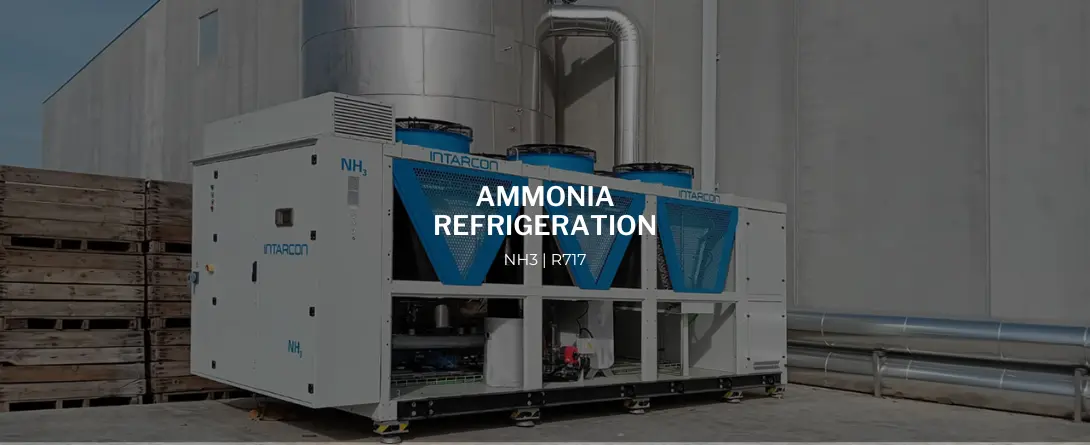Ammonia refrigeration (NH3 – R717)
INTARCON2024-04-22T10:16:40+02:00Ammonia or NH3 is a natural refrigerant of type L2, mainly used in large industrial plants, known as chillers or chiller plants. NH3 refrigeration technology stands out for its excellent thermodynamic properties.
Its performance allows its application in medium and low temperatures, reaching temperatures down to -70 ºC.
Ammonia properties (NH3 - R717)
| Main characteristics of ammonia | |
| Chemical formula | NH3 |
| Liquid density at +20°C | 610 kg/m3 |
| Gas density at +20ºC | 0,78kg/m3 |
| Relative gas density (with respect to air) | 0,6 |
| Triple point | -77,7 ºC |
| Evaporating temperature at 1,013 bar | -33,4 ºC |
| Ignition temperature (DIN 51794) | + 651 ºC |
| Explosive concentration in volume | 15-28% |
| Explosive concentration by weight | 114-212,8 g/m3 |
| Explosive concentration in p.p.m. | 150000 – 280000 ppm |
| Volume increase with change of state | 800 times |
| Very soluble in water (litres NH3/litre water) | 1140 a 0ºC |
| Causes skin burns | |
| Required quality of ammonia for use as a refrigerant | |
| Purity | 99,98% |
| Maximum water content | 150 ppm |
| Waste oil | 3 ppm |
| Uncondensable | 0,2 ml/g |
Why is ammonia used in refrigeration?
- The destruction of the ozone layer led to its prohibition through the Montreal Protocol.
- Global warming as a consequence of the emission of greenhouse gases. This led to the need to limit and even ban the use of HFCs, which had been introduced as substitutes for CFCs and HCFCs. In order to regularise this situation, the Kyoto Protocol was formalised.
- Synthesising new refrigerants, although after their failure and the banning of the well-known HFCs as “substitutes”, this alternative would only lead to the unknown.
- Use known natural refrigerants that are compatible with environmental protection.
- Air(R-729)
- Water (R-718)
- Carbon dioxide or CO2 (R-744)
- Ammonia or NH3 (R-717)
Benefits and advantages of ammonia refrigeration
Benefits
- Efficiency and higher performance than other HFC gases such as R134a, R290 or even CO2.
- Reliability and safety due to the current regulations governing the safe application on your premises and its characteristic odour, easy to identify in case of leakage.
- Environmental sustainability. R717 is a natural refrigerant with zero GWP and ODP.
- Smart investment, due to its fast return on investment at maximum yield.
Advantages
- Energy efficiency. Thanks to its excellent thermodynamic properties, electricity consumption is reduced and a quick return on investment is achieved.
- Low maintenance. It is an optimised and compact system thanks to the functionality of its refrigeration system.
- Cost-effectiveness, due to the abundance of this natural refrigerant, its cost is low.
- Low refrigerant charge. Thanks to the critical charge design without receiver, it also incorporates energy-saving components.
- No need for a machine room. System with built-in air condenser, designed for outdoor installation.
- No water consumption. Thanks to air condensation for temperatures up to 47ºC, the system is therefore free from the risk of legionellosis.
- Compatibility of an indirect variable flow glycol refrigeration system (optional).
- Lower manufacturing cost. Its refrigeration system uses smaller diameter steel pipes, resulting in savings.
What are the applications of ammonia refrigeration?
- Industrial slaughterhouses: Used in activities such as preservation, freezing chambers and cutting rooms, where it guarantees efficient cooling of the product, maintaining optimum temperature and humidity conditions.
- Fruit and vegetable stores: Essential for maintaining optimum temperature and humidity conditions, preserving the quality of the products during storage. It is also used in controlled atmosphere chambers to delay the ripening of certain fruits.
- Fishing industry: Used in the preservation of fresh and frozen products, ensuring adequate temperatures for the preservation of fish in ice factories and preservation chambers.
- Dairy industries and dairies: Used for the cooling and preservation of milk and its derivatives, coordinating the thermal load with the production of cold to ensure energy efficiency.
- Beverage factories: It manages the temperature during fermentation processes, preventing water crystallisation and ensuring the proper development of yeast strains.
- Plastics industry: Controls the temperature in the transformation of plastics, guaranteeing the desired shape of the moulded parts.
- Other industrial processes: Used in cooling of welding equipment, automotive, aeronautics and other processes requiring precise temperature control.
Price
Life cycle calculation. R717 refrigeration plant – Project data.
| NH3 refrigeration installation | |
| Yearly “handling” hours (staff working for loading/unloading and other activities): | 3.840h |
| Remaining hours per year in “maintenance” regime | 4.920h |
| Refrigeration capacity | 1.200 kW |
| Rated hourly power absorbed by compressors | 325 kW |
| Average annual power absorbed by compressors in handling mode | 230 kW |
| Nominal hourly power absorbed by auxiliary equipment (fans, pumps, electrical resistance, etc.) | |
| Average hourly power absorbed by auxiliary equipment in handling mode | 38 kW |
| Average hourly power absorbed by compressors in maintenance mode (4,920h) | 120 kW |
| Average hourly power absorbed by auxiliary equipment in maintenance mode (4,920h) | 22 kW |
| Life cycle considered | 15 years |
| Current cost of electricity | 0,11€/kWh |
| Annual energy price increase | 3% |
| Average cost of electricity over 15 years | 0,14€/kWh |
| Average interest on money | 5% per year |
| Annual maintenance costs of the refrigeration plant | 4% acquisition price |
Life cycle calculation. R717 refrigeration installation – Economic Analysis.
| Costs distributed over 15 years | |
| Previous studies: €30,000 | 2.000€ |
| Complete refrigeration plant € 940,000 with interest | 90.562€ |
| Auxiliary installations for the refrigeration plant 180.000€ (electrical, water, compressed air, etc.) | 17.342€ |
| Average annual energy costs over the 15 years: 1.631.280 kW-h x 0,14€/kW | 228.379€ |
| Cold plant operating costs (1 operator 20% time) | 6.600€ |
| Maintenance costs (refrigeration and auxiliary installations) | 3.000€ |
| Environmental costs | 2.000€ |
| Decommissioning costs (60,000 €/15) | 4.000€ |
| Total annual cost | 353.883€ |
| Electricity consumption as a percentage of total consumption: 65%. | |
Ammonia refrigeration precautions
- It is compulsory to contract preventive maintenance with an authorised company, which according to RD 552/2019 is compulsory for level installations.
- Maintenance must be carried out in accordance with the instruction manual provided by the manufacturer. It should not be forgotten that non-compliance with the frequency and/or scope of inspections can lead to a loss of guarantees and, furthermore, disregards the principle of preventive action (Law 31/1995 and RD 486/1997).
- Over the last few years there has been a noticeable increase in counterfeits in the refrigeration industry and it is up to the user to demand that a certificate issued by the original manufacturer or an equivalent certificate is presented in order to ensure compliance with national and international legislation that may apply.
Applicable regulations
As ammonia is a refrigerant that has been used with compression equipment since 1876, a series of standards and regulations have been developed to guarantee the best safety for people, the environment and stored products, and in the European Union the standard recognised by all member states is EN 378 “Refrigeration systems and heat pumps. Safety and environmental requirements”, which is aligned with the international safety standard ISO 5149. EN 378, has incorporated new features such as:
- Part 1. Introduction of flammability category 2L. A charge calculation method based on refrigerant classification and the addition of two new alternative methods.
- Part 2. Changes to the flow charts used for the determination of protective device requirements.
- Part 3. Changes to the requirements for engine rooms.
- Part 4. Arrangements for handling ammonia vapour.
However, each country has its own rules and regulations.
In Europe, the regulations applicable to ammonia refrigeration are mainly regulated by Directive 2014/68/EU on pressure equipment and Directive 2009/29/EC on the limitation of emissions of fluorinated greenhouse gases.
Directive 2014/68/EU sets out design, manufacturing, inspection and conformity requirements for pressure equipment, including refrigeration systems using ammonia as a refrigerant. These requirements aim to ensure the safety and integrity of equipment and to prevent accidents.
On the other hand, Directive 2009/29/EC aims to reduce emissions of fluorinated gases, including many of the synthetic refrigerants used in refrigeration systems. This may influence the choice of more environmentally friendly alternative refrigerants, such as ammonia, in refrigeration systems.
Some of the existing regulations in other territories are for example:
- United States:
- Clean Air Act (Title VI): Regulates emissions of fluorinated gases, including refrigerants used in refrigeration systems.
- Occupational Safety and Health Administration (OSHA): Establishes occupational safety standards related to the handling of ammonia in work environments.
- Canada:
- Canadian Environmental Protection Act: regulates the handling and emissions of hazardous substances, including refrigerants such as ammonia.
- Provincial Occupational Safety Regulations: May establish additional requirements for the safe handling of ammonia in work environments.
- Australia:
- Chemical Control Act: regulates the safe handling of hazardous chemicals, including ammonia.
- State Workplace Safety Regulations: Set requirements for the safe handling of ammonia in work environments.
- Japan:
- Chemical Substance Control Law: regulates the safe handling of hazardous chemicals, including ammonia.
- Ministry of Economy, Trade and Industry (METI) Regulations: May establish additional requirements for the safe handling of refrigerants.
Related Posts

Keep goblins out of your cooling system: 10 installation mistakes to avoid
I must confess that I have a knock, when I visit installations or when I see photos on the networks.... read more

Prevent your competition from overtaking you: Improve your EBITDA with CAES
When you are looking to improve your company's competitiveness, it makes sense to focus on the investments that offer the... read more



